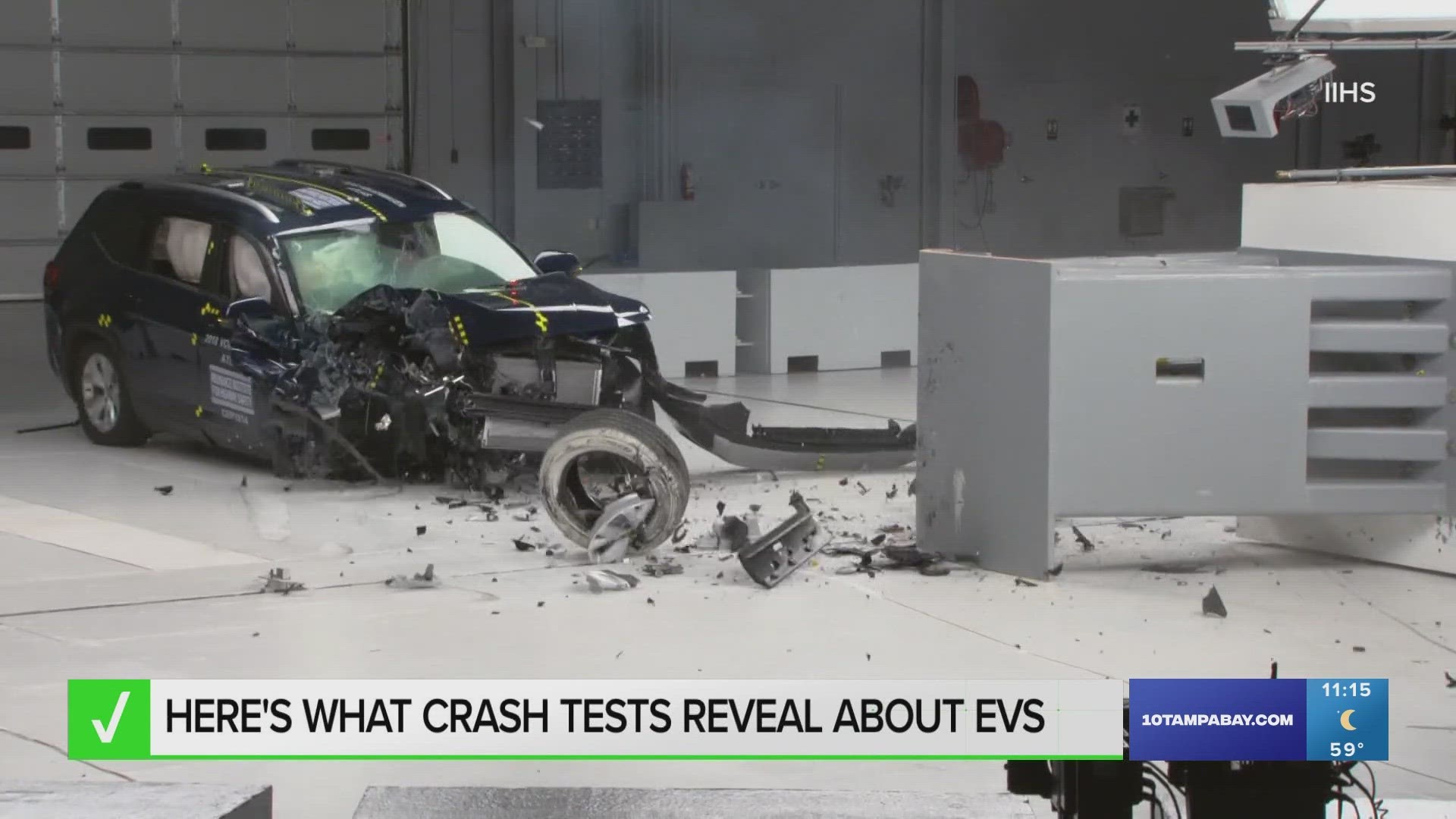ST. PETERSBURG, Fla. — More and more Florida drivers are opting to plug in instead of gas up with the number of registered electric vehicles in the state nearly tripling since the pandemic.
There were 58,160 registered electric vehicles in Florida at the end of 2020, according to the U.S. Department of Energy. That number grew to nearly 168,000 by the end of 2022, the most recent year for which data is available.
That same data shows only California has more registered EVs than Florida. Overall, however, EVs still account for just a fraction of all vehicles on the road.
Carol D. in Tarpon Springs asked VERIFY which fares better in a crash after hearing electric vehicles might not be as safe as traditional gas-powered vehicles.
Here’s what we can VERIFY:
THE QUESTION
Are electric vehicles less safe in a crash compared to gas-powered vehicles?
THE SOURCES
- National Transportation Safety Board (NTSB)
- National Highway Traffic Safety Administration (NHSTA)
- Insurance Institute for Highway Safety (IIHS)
- Raul Arbelaez, vice president of vehicle research, IIHS
- U.S. Department of Energy
THE ANSWER
No, electric vehicles are not less safe in a crash. Tests have found EVs keep occupants just as safe as, if not safer than, other vehicles in a crash. But safety advocates say their additional weight is putting other drivers and pedestrians at risk.
WHAT WE FOUND
All passenger vehicles sold in the U.S. – including EVs – must undergo extensive testing and meet Federal Motor Vehicle Safety Standards.
The Insurance Institute for Highway Safety (IIHS) – a non-government agency considered the gold standard of safety ratings – has found EVs perform just as well as gas-powered vehicles in dozens of crash tests.
Several EVs on the road today are considered "top safety picks" by the IIHS for earning the agency's highest "good" rating in front and side crash tests.
Testing has shown electric vehicles appear to offer superior protection to their occupants due to their additional weight, according to Raul Arbelaez, the vice president of the vehicle research center at the IIHS.
The extra weight comes from their outsized batteries needed to achieve a travel range of about 300 miles per charge.
Data compiled by the IIHS from 2011-19 shows rates of injury claims for occupants in EVs were more than 40 percent lower than for identical gas-powered models.
When the IIHS first started crash testing EVs in 2011, Arbelaez said his biggest concern was fire risk. But more than a decade and several dozen tests later, he says no EV has ever caught fire in a crash test.
NHTSA concludes electric vehicles do not present a greater risk of post-crash fire than gasoline-powered vehicles. The federal agency says all vehicles—both electric and gasoline-powered—have some risk of fire in the event of a serious crash.
Arbelaez says his concern now lies with the growing bulk of EV batteries and the increasing risk he believes the added weight poses to occupants of other vehicles and pedestrians in a crash.
Electric vehicles typically weigh 20 to 50 percent more than gas-powered vehicles. In some cases, a battery can weigh almost as much as a small gas-powered car.
“Vehicle weights have been going up and now when you add all of the additional battery mass that is needed for electric vehicles … we are going to have an issue with mass disparities between bigger vehicles and smaller vehicles,” Arbelaez told 10 Tampa Bay.
“The heavier something is that hits you, the more severe it's going to be on you.”
A 1,000-pound difference between vehicles can result in a nearly 50-percent increase in the likelihood of the crash becoming deadly, according to a 2011 study conducted by the National Bureau of Economic Research.
Some of the newest EVs on the road today weigh in at several thousand pounds more than the average vehicle. According to Edmunds, the battery alone in General Motors’ Hummer EV weighs nearly as much as an entire Toyota Corolla.
Newly released crash data compiled by engineers at the University of Nebraska indicate the nation's guardrail system can't handle heavy EVs. Guardrails are intended to keep cars from careening off the road in critical areas, such as over bridges and waterways, near the edges of cliffs and ravines and over rocky terrain, where injury and death in an off-the-road crash are much more likely.
The preliminary crash test sponsored by the U.S. Army Corps of Engineers’ Research and Development Center involved a Rivian truck. Notably, the truck showed almost no damage to the cab's interior after slamming into the concrete barrier.
Federal regulators are pushing to make collision avoidance and auto braking systems standard in all new vehicles to compensate for growing weight disparities in vehicles.
Arbelaez says the hope is that as technology improves, batteries will become smaller and lighter while offering greater range.
The Associated Press contributed to this report.

